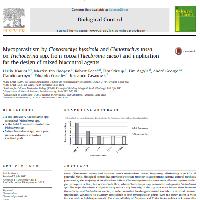Resumen
- Cocoa (Theobroma cacao) pod diseases cause tremendous losses, frequently eliminating over 80% of potential yield. Biological control has previously shown promise to supplement cultural control methods practiced by the majority of smallholders. Mixed Clonostachys inocula were most effective against multiple pathogens in Peru, but not in Costa Rica, where Clonostachys spp. seemed to antagonize Trichoderma spp. The objective of our study was to systematically investigate the mycoparasitic interactions between Clonostachys and Trichoderma species, in order to enable the design of mixed inocula in a rational manner. Specifically, we aimed to quantify dominance of one mycoparasite genus over the other using in vitro tests as well as field experiments. The compatibility of Peruvian and Costa Rican isolates of known efficacy was tested by pair-wise confrontations on water agar as well as two host-range assays, one of which mycoparasites were offered another mycoparasite as only host and one where conidia of a Clonostachys and a Trichoderma isolate were mixed at ratios ranging from 1:100 to 100:1 in order to determine dominance on the susceptible host, Phytophthora palmivora. A field study quantified survival and establishment of selected mixtures on surface-sterilized cocoa pods. Hyphal interactions and host-range studies coincided in identifying Clonostachys rosea as the most aggressive mycoparasite, closely followed by C. byssicola. Trichoderma spp. were least aggressive; instead, they were highly susceptible to Clonostachys spp. The outcome of interactions depended on the species used and occasionally even on the isolates confronting each other. The country of origin, however, was irrelevant. Parasitic growth of C. rosea was unaffected by Trichoderma harzianum, even at an inoculum ratio of 1:100. Parasitic growth of Trichoderma spp. progressively slowed as C. rosea concentrations rose, but the effect varied in strength with different isolates. When C. rosea and Trichoderma sp. were applied to cocoa pods in the field either separately or in combination at a ratio of 5:1, C. rosea dominated at the expense of Trichoderma sp., which was suppressed. At equal or ten times higher concentrations of T. harzianum, C. rosea was temporarily suppressed, but from two weeks after application, remained the dominant and persistent pod colonizer. Native Trichoderma spp. were poor pioneer colonizers of surface-sterilized pods and applied populations vanished within less than four weeks. Our results suggest that, although Clonostachys spp. antagonize Trichoderma spp., the incompatibility can be partly overcome by adjusting the inoculum ratio of mixed inocula in favor of Trichoderma spp. Therefore, mycoparasitism among several promising biocontrol candidates do not necessarily rule out their combination into a mixed inoculum, but can be addressed by formulating susceptible isolates at higher inoculum ratios. This, however, will not sustainably improve surface coverage by poorly colonizing Trichoderma spp. Therefore, optimal strains for the habitat and task are needed first.
